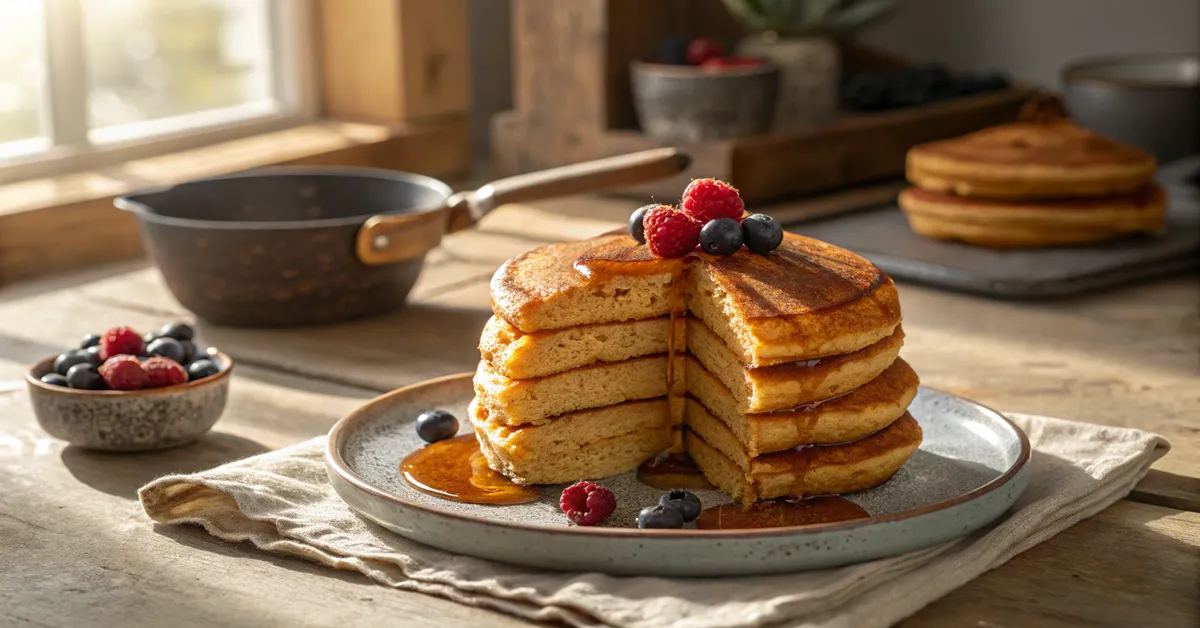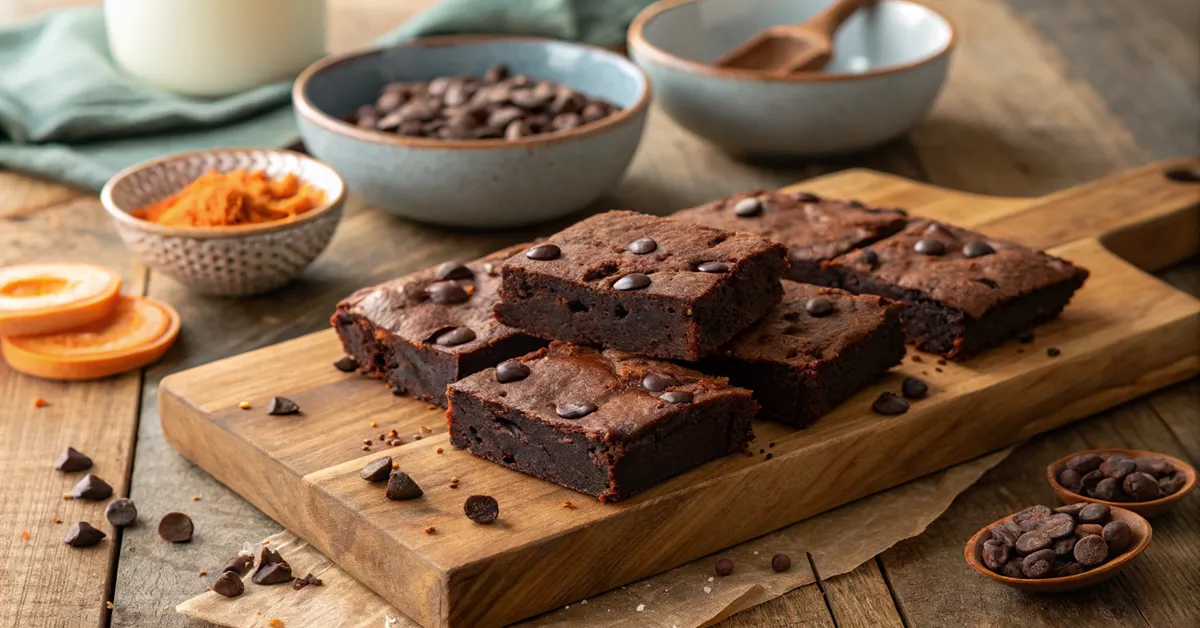7 Mediterranean Plant Protein Power Bowl Benefits That’ll Change Your Lunch Game
So there I was last Tuesday, standing in front of my sad, half-empty fridge at 2 PM, my energy totally crashed and craving something that wouldn’t leave me in that awful post-lunch coma. That’s when I remembered the amazing Mediterranean plant protein power bowl my neighbor Sofia made when we cooked together last weekend – this incredible, colorful meal that actually kept me full and energized for hours.
You know what? I’ve been making these bowls for months now, and they’re honestly a game-changer. A Mediterranean plant protein power bowl isn’t just some trendy Instagram food – it’s actually a really smart way to eat that combines the best of traditional Mediterranean cooking with what we know about nutrition today.
The coolest part? These bowls give you complete proteins from plants. I had no idea this was even possible before I started making them, but when you combine certain ingredients like quinoa and chickpeas, you’re getting all the amino acids your body needs. Pretty amazing, right?
Table of Contents
Table of Contents
Why Mediterranean Plant Protein Power Bowls are Game-Changers?
Ever wonder why people from Mediterranean countries seem to stay healthy and energetic well into their golden years?
The Magic of Complete Plant Proteins
Here’s something that totally blew my mind when I first learned about it. Most plant proteins are missing some of the essential amino acids our bodies need, which is why people always say you need meat for complete protein. But – and this is the cool part – when you combine certain plants together, they complete each other!
Consider a Mediterranean protein bowl with quinoa and chickpeas. The quinoa has some amino acids, the chickpeas have others, and together they make a complete protein that’s just as good as chicken or fish. My energy levels completely changed once I understood this. No more 3 PM crashes, no more being hungry an hour after lunch.
I’ve been experimenting with different combinations for months now, and it’s honestly like discovering a nutritional superpower. The Mediterranean people figured this out centuries ago without even knowing the science behind it – they just knew these combinations made them feel good.
| What Goes Together | Complete Protein? | How Much Protein | Why It Works |
| Quinoa + Chickpeas | Yes! | 22-26g per bowl | Ancient grains meet legumes |
| Tahini + Hemp seeds | Yes! | 18-22g per bowl | Sesame power with super seeds |
| Lentils + Pumpkin seeds | Yes! | 20-24g per bowl | Perfect amino acid match |
| White beans + Pine nuts | Yes! | 16-20g per bowl | Classic Mediterranean combo |
Want to explore more protein combinations? Check out our Mediterranean breakfast bowl guide for morning versions, and don’t miss our gluten-free Mediterranean recipes if you’re avoiding gluten.
Why Eating from a Bowl Actually Makes a Difference
This might sound silly, but there’s actually science behind why eating from a bowl works better than a regular plate. When you arrange your Mediterranean plant protein power bowl with different sections and colors, your brain gets more satisfied signals. I’ve tested this myself – same exact food on a plate versus in a bowl, and the bowl version keeps me full way longer.
Plus, you can have warm roasted veggies next to cool cucumber and room-temperature grains all in one bowl. It’s like getting different temperatures and textures in every bite, which keeps things interesting. Trust me, once you start eating this way, regular salads feel kind of boring.
Print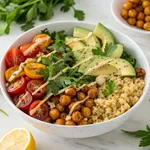
Mediterranean Plant Protein Power Bowl
- Total Time: 45 minutes
- Yield: 2 servings 1x
- Diet: Vegetarian
Description
A nutrient-dense Mediterranean plant protein power bowl featuring complete proteins from quinoa and legumes, healthy fats from tahini, and vibrant vegetables for sustained energy and optimal nutrition.
Ingredients
Your Base (Pick 1 or 2):
1/2 cup cooked quinoa (my personal favorite!)
1/3 cup cooked bulgur wheat
1/4 cup cooked farro
The Protein Stars (Use 2-3 of these):
1/3 cup roasted chickpeas (game-changer for crunch!)
1/4 cup cooked lentils (any color works)
1/4 cup cannellini beans
2 tablespoons tahini (sesame seed butter)
1 tablespoon hemp hearts (tiny but mighty)
1 tablespoon pumpkin seeds
Fresh Veggies:
2 cups mixed greens (whatever you like)
1/2 cup cherry tomatoes, cut in half
1/2 cucumber, diced
1/4 red onion, sliced thin
1/4 cup roasted red peppers
The Flavor Boosters:
2 tablespoons Kalamata olives
1/4 cup sun-dried tomatoes
2 tablespoons fresh herbs (parsley, mint, or basil)
1/4 avocado, sliced
Simple Dressing:
3 tablespoons good olive oil
2 tablespoons fresh lemon juice
1 tablespoon apple cider vinegar
1 teaspoon Dijon mustard
1 clove garlic, minced
1 teaspoon dried oregano
Instructions
Step 1: Get Your Grains Ready (15 minutes) Cook your grains however the package says, but here’s my secret trick – while they’re still warm, add a splash of lemon juice, some sea salt, and a little olive oil. Warm grains are like sponges for flavor! I learned this from a Lebanese chef, and it’s a total game-changer.
Step 2: Make Those Chickpeas Crispy (25 minutes) Heat your oven to 425°F. Drain and rinse the chickpeas, making sure to dry them really well with paper towels. Toss them with olive oil, cumin, paprika, garlic powder, and salt. Roast for 20-25 minutes, and give the pan a shake halfway through. They should be golden and crispy – this is what makes your Mediterranean plant protein power bowl special.
Step 3: Prep Your Fresh Stuff (10 minutes) While the chickpeas are roasting, wash and chop your vegetables. Pro tip: keep wet things like tomatoes and cucumber separate until the very end so they don’t make everything soggy.
Step 4: Mix Up That Dressing Just whisk together olive oil, lemon juice, minced garlic, oregano, salt, and pepper. Taste it – it should be bright and make your mouth happy.
Step 5: Assembly Time! Start with your greens at the bottom, then add your grains in one section. Arrange your colorful veggies in different sections around the bowl – it should look like a rainbow! Top with those crispy chickpeas, sprinkle your seeds and herbs, and drizzle the dressing right before you eat.
Notes
- Store components separately for best freshness.
- Can be made gluten-free by omitting bulgur wheat.
- Adjust protein content based on individual needs.
- Prep Time: 20 minutes
- Cook Time: 25 minutes
- Category: Mediterranean launch recipe
- Method: Assembly, Roasting
- Cuisine: Mediterranean
Nutrition
- Serving Size: 1 bowl
- Calories: 485 kcal
- Sugar: 8g
- Sodium: 380 mg
- Fat: 24g
- Saturated Fat: 3g
- Unsaturated Fat: 21g
- Trans Fat: 0g
- Carbohydrates: 52g
- Fiber: 12g
- Protein: 22g
- Cholesterol: 0mg
Essential Ingredients for Your Perfect Mediterranean Plant Protein Power Bowl
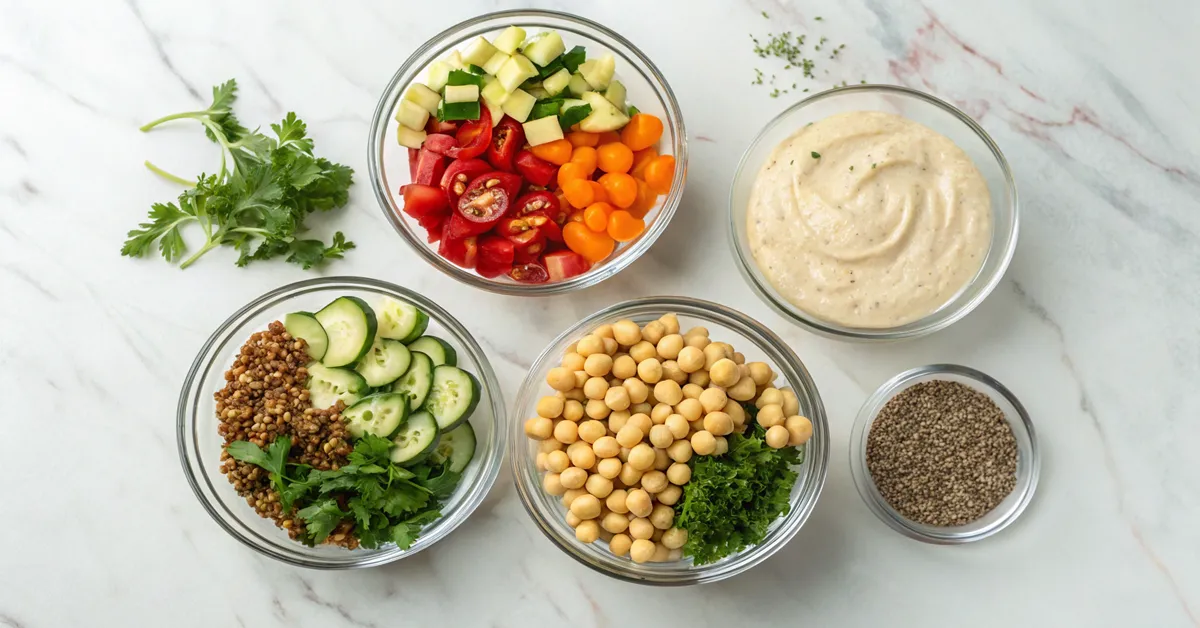
What actually goes into these magical bowls that makes them so satisfying?
Ingredients List for The Mediterranean Plant Protein Power Bowl
Your Base (Pick 1 or 2):
- 1/2 cup cooked quinoa (my personal favorite!)
- 1/3 cup cooked bulgur wheat
- 1/4 cup cooked farro
The Protein Stars (Use 2-3 of these):
- 1/3 cup roasted chickpeas (game-changer for crunch!)
- 1/4 cup cooked lentils (any color works)
- 1/4 cup cannellini beans
- 2 tablespoons tahini (sesame seed butter)
- 1 tablespoon hemp hearts (tiny but mighty)
- 1 tablespoon pumpkin seeds
Fresh Veggies:
- 2 cups mixed greens (whatever you like)
- 1/2 cup cherry tomatoes, cut in half
- 1/2 cucumber, diced
- 1/4 red onion, sliced thin
- 1/4 cup roasted red peppers
The Flavor Boosters:
- 2 tablespoons Kalamata olives
- 1/4 cup sun-dried tomatoes
- 2 tablespoons fresh herbs (parsley, mint, or basil)
- 1/4 avocado, sliced
Simple Dressing:
- 3 tablespoons good olive oil
- 2 tablespoons fresh lemon juice
- 1 tablespoon apple cider vinegar
- 1 teaspoon Dijon mustard
- 1 clove garlic, minced
- 1 teaspoon dried oregano
Building Your Flavor Foundation
Let me tell you what I’ve learned about making a Mediterranean plant protein power bowl that actually tastes incredible. It’s all about treating each ingredient with respect before you put everything together.
I used to just toss everything in a bowl and hope it turned out okay. Big mistake! Now I season my grains while they’re still warm (they absorb flavor like crazy), I make sure my chickpeas are properly roasted until crispy, and I don’t just dump raw veggies in there.
The protein layering is where it gets fun in the Mediterranean Plant Protein Power Bowl. Instead of just adding one protein source, I spread different ones throughout. So I might start with quinoa (that’s 8g of protein right there), add some crispy chickpeas (another 6g), finish with tahini dressing (4g more), and sprinkle hemp hearts on top (3g). Boom – 21g of complete protein that keeps me satisfied for hours.
For more ideas on how to prep your grains perfectly, check out our couscous and quinoa salad recipe. And if you want to see how the pros do grain prep, our red quinoa tabbouleh is amazing.
How to Build Your Mediterranean Plant Protein Power Bowl?
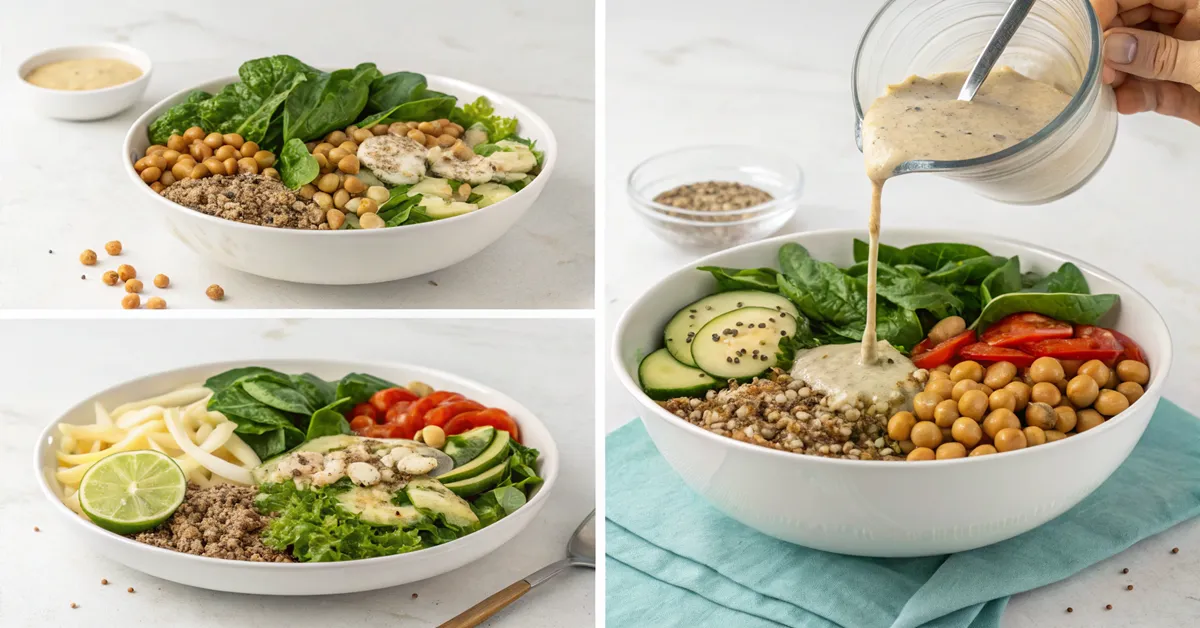
Ready to put this all together? Here’s how to make it look and taste amazing.
Step-by-Step Instructions
Step 1: Get Your Grains Ready (15 minutes) Cook your grains however the package says, but here’s my secret trick – while they’re still warm, add a splash of lemon juice, some sea salt, and a little olive oil. Warm grains are like sponges for flavor! I learned this from a Lebanese chef, and it’s a total game-changer.
Step 2: Make Those Chickpeas Crispy (25 minutes) Heat your oven to 425°F. Drain and rinse the chickpeas, making sure to dry them really well with paper towels. Toss them with olive oil, cumin, paprika, garlic powder, and salt. Roast for 20-25 minutes, and give the pan a shake halfway through. They should be golden and crispy – this is what makes your Mediterranean plant protein power bowl special.
Step 3: Prep Your Fresh Stuff (10 minutes) While the chickpeas are roasting, wash and chop your vegetables. Pro tip: keep wet things like tomatoes and cucumber separate until the very end so they don’t make everything soggy.
Step 4: Mix Up That Dressing Just whisk together olive oil, lemon juice, minced garlic, oregano, salt, and pepper. Taste it – it should be bright and make your mouth happy.
Step 5: Assembly Time! Start with your greens at the bottom, then add your grains in one section. Arrange your colorful veggies in different sections around the bowl – it should look like a rainbow! Top with those crispy chickpeas, sprinkle your seeds and herbs, and drizzle the dressing right before you eat.
| What You’re Doing | How to Do It | How Long It Lasts | My Best Tip |
| Cooking grains | Season while warm | 5 days in fridge | Let them cool completely before storing |
| Roasting chickpeas | High heat for crispiness | 4 days at room temp | Store with paper towels to stay crispy |
| Chopping vegetables | Cut everything the same size | 3 days in fridge | Keep wet and dry stuff separate |
| Making dressing | Whisk until smooth | 2 weeks in fridge | Add water bit by bit if it’s too thick |
Assembly Tips That Actually Work
I made so many sad, soggy bowls when I first started because I didn’t understand that each part of your Mediterranean plant protein power bowl needs individual attention. Now I treat each ingredient like it’s the star of its own show before bringing them all together.
I roast my vegetables with specific herbs, I make sure my grains have flavor before they go in the bowl, and I never, ever use bland legumes. When every component tastes good on its own, the whole Mediterranean plant protein power bowl becomes amazing.
Want to see how other people do bowl assembly? Our Mediterranean salmon bowl guide has some great techniques, and our orzo pesto pasta salad shows perfect grain prep.
What Makes Mediterranean Plant Protein Power Bowl Perfect for Meal Prep?
Honestly, this is where these bowls really shine – they’re perfect for busy people who still want to eat well.
Storage And Meal Prep Tips
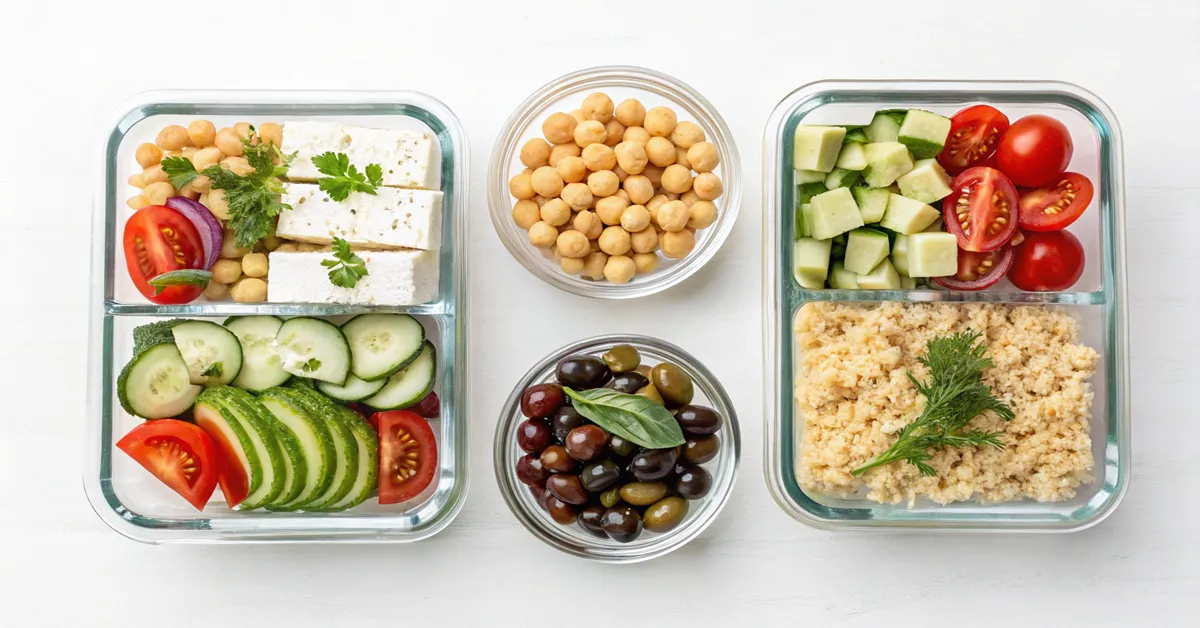
After making hundreds of these bowls (seriously!), I’ve figured out the perfect Mediterranean plant protein power bowl meal prep system. The trick is knowing what gets better with time and what needs to stay fresh.
My Sunday Routine (takes about 2 hours):
The Big Batch Cooking:
- Cook 2-3 different grains in big batches
- Roast chickpeas and whatever vegetables are in season
- Make different legume preparations
- Whip up big batches of tahini dressing
Smart Storage:
- Glass containers with good lids are everything
- Keep wet stuff (tomatoes, cucumbers) separate
- Put dressings in squeeze bottles or small jars
- Layer things so nothing gets soggy
The cool thing about Mediterranean plant protein power bowls is that some parts actually taste better the next day. The grains absorb more flavor, the roasted vegetables develop deeper tastes, and the legumes get more flavorful. It’s like the bowl improves with time!
Mediterranean Plant Protein Power Bowl:Customization & Variations
The best part about these bowls? You can totally make them work for whatever diet you’re following. Need gluten-free? Swap bulgur for quinoa. Want more protein? Add extra hemp seeds. Following keto? Load up on the healthy fats and skip some of the grains.
Seasonal Swaps That Work:
- Spring: Fresh peas, asparagus, mint, tender herbs
- Summer: Tomatoes, zucchini, basil, cucumber
- Fall: Roasted squash, pomegranate seeds, hearty kale
- Winter: Root vegetables, preserved lemons, sturdy greens
Making It Work for Your Diet:
- No gluten: Use quinoa instead of bulgur
- More protein: Double up on legumes and seeds
- Lower carb: More greens, fewer grains, extra healthy fats
- No nuts: Use sunflower seed butter instead of tahini
| What You Need | Easy Swaps | Protein Boost | More Flavor |
| Gluten-free | Quinoa for bulgur | Add hemp seeds | Fresh lemon zest |
| Higher protein | Double the beans | Include tahini | Fresh herbs everywhere |
| Lower carb | More greens, less grain | Pumpkin seeds | Olive tapenade |
| Nut-free | Sunflower seed butter | More chickpeas | Extra fresh garlic |
Check out our Mediterranean shrimp bowl if you want to add seafood, and our tuna and white bean salad for more protein ideas.
FAQ Section About Mediterranean Plant Protein Power Bowl
What is a Mediterranean power bowl?
A Mediterranean plant protein power bowl is basically a complete meal in a bowl that combines plant proteins, whole grains, fresh vegetables, and healthy fats using ingredients and flavors from Mediterranean cooking. Think of it as a salad’s more substantial, more satisfying cousin!
Are Mediterranean bowls good for you?
Absolutely! These bowls are packed with complete proteins, heart-healthy fats, fiber, vitamins, and antioxidants. They follow the Mediterranean diet pattern, which tons of research shows can help with heart health, brain function, and living longer.
What are plant-based proteins on the Mediterranean diet?
The main plant proteins in Mediterranean cooking are legumes like chickpeas, lentils, and white beans, plus nuts and seeds like tahini, pine nuts, and hemp hearts. Whole grains like quinoa and bulgur add protein too. The magic happens when you combine them!
Are power bowls healthy for you?
When they’re made right, yes! A good power bowl gives you complete nutrition in one meal – proteins, complex carbs, healthy fats, and tons of vitamins and minerals. The Mediterranean plant protein power bowl is especially great because it focuses on anti-inflammatory ingredients.
What is a power bowl for weight loss?
A weight-loss power bowl emphasizes ingredients that keep you full – high fiber, lots of protein, and healthy fats. The Mediterranean plant protein power bowl is perfect for this because the plant proteins and fiber help you feel satisfied for hours without blood sugar spikes.
What’s the difference between a protein bowl and a salad?
Good question! Protein bowls are served in deeper bowls with distinct sections, they include warm and cold elements together, and they’re specifically designed to give you 15-25g of protein per serving. Regular salads are usually just leafy greens on a plate and might not have enough protein to keep you full.
Ready to Start Your Mediterranean Plant Protein Power Bowl Journey?
Why stick with boring lunches when you could be eating something this delicious and nutritious every day?
Getting Started This Week with Mediterranean plant protein power bowls
Here’s the thing about Mediterranean plant protein power bowls – you don’t need to buy a bunch of fancy ingredients or completely change how you shop. Start simple. Cook some quinoa this weekend, grab a can of chickpeas, add whatever vegetables you like, and make a basic tahini dressing.
I always tell people to start with just making two bowls for the week instead of trying to meal prep five days’ worth right away. You want to figure out what combinations you actually like and what keeps you satisfied. Pay attention to how you feel after eating different ratios of ingredients.
Building Your Bowl Community
One of the coolest unexpected benefits of making Mediterranean plant protein power bowls has been how they’ve brought people together. Coworkers ask about my colorful lunches, friends want to learn how to make them, and I’ve even hosted bowl-building parties where everyone brings one ingredient.
Consider starting small – maybe suggest a group meal prep session with a few friends or coworkers. Everyone brings one component, and you all assemble bowls together. It’s amazing how much more creative you get when you’re working with other people’s ideas, and it makes the whole process more fun and social.
The Mediterranean diet isn’t just about food; it’s about coming together and sharing meals. These bowls just make it easier to do that, even in our busy modern lives. Having everyone add their own ingredients means you get to discover new flavor combinations you might not have tried on your own
Final Thoughts About Mediterranean plant protein power bowl
You know what I love most about the Mediterranean plant protein power bowl? It’s made eating healthy feel less like work and more like something I actually look forward to. After months of making these bowls, I can honestly say they’ve changed how I think about lunch.
What’s great is that it’s really easy to make once you’ve done it a couple of times. You’re not following some complicated diet plan or counting every calorie – you’re just combining ingredients that Mediterranean people have been eating together for thousands of years. They figured out long ago that these combinations work, and now we know why.
I used to be that person who ate sad desk salads or grabbed whatever was convenient when I got hungry. Now I actually plan my Mediterranean plant protein power bowls because I know they’ll keep me satisfied and energized all afternoon. No more 3 PM energy crashes or mindless snacking.
The flexibility is amazing too. Seasonal vegetables, different grains, various legumes – every bowl can be different, which means you never get bored. And when friends see these colorful, Instagram-worthy bowls, they always want the recipe!


